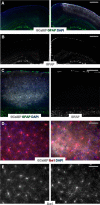Astrocytic Gq-GPCR-linked IP3R-dependent Ca2+ signaling does not mediate neurovascular coupling in mouse visual cortex in vivo
- PMID: 25253859
- PMCID: PMC4172806
- DOI: 10.1523/JNEUROSCI.2591-14.2014
Astrocytic Gq-GPCR-linked IP3R-dependent Ca2+ signaling does not mediate neurovascular coupling in mouse visual cortex in vivo
Abstract
Local blood flow is modulated in response to changing patterns of neuronal activity (Roy and Sherrington, 1890), a process termed neurovascular coupling. It has been proposed that the central cellular pathway driving this process is astrocytic Gq-GPCR-linked IP3R-dependent Ca(2+) signaling, though in vivo tests of this hypothesis are largely lacking. We examined the impact of astrocytic Gq-GPCR and IP3R-dependent Ca(2+) signaling on cortical blood flow in awake, lightly sedated, responsive mice using multiphoton laser-scanning microscopy and novel genetic tools that enable the selective manipulation of astrocytic signaling pathways in vivo. Selective stimulation of astrocytic Gq-GPCR cascades and downstream Ca(2+) signaling with the hM3Dq DREADD (designer receptors exclusively activated by designer drugs) designer receptor system was insufficient to modulate basal cortical blood flow. We found no evidence of observable astrocyte endfeet Ca(2+) elevations following physiological visual stimulation despite robust dilations of adjacent arterioles using cyto-GCaMP3 and Lck-GCaMP6s, the most sensitive Ca(2+) indicator available. Astrocytic Ca(2+) elevations could be evoked when inducing the startle response with unexpected air puffs. However, startle-induced astrocytic Ca(2+) signals did not precede corresponding startle-induced hemodynamic changes. Further, neurovascular coupling was intact in lightly sedated, responsive mice genetically lacking astrocytic IP3R-dependent Ca(2+) signaling (IP3R2 KO). These data demonstrate that astrocytic Gq-GPCR-linked IP3R-dependent Ca(2+) signaling does not mediate neurovascular coupling in visual cortex of awake, lightly sedated, responsive mice.
Keywords: DREADD; IP3; astrocyte; blood flow; calcium; in vivo.
Copyright © 2014 the authors 0270-6474/14/3313139-12$15.00/0.
Figures






Comment in
-
The functional role of astrocyte calcium signaling in cortical blood flow regulation.J Neurosci. 2015 Jan 21;35(3):868-70. doi: 10.1523/JNEUROSCI.4422-14.2015. J Neurosci. 2015. PMID: 25609605 Free PMC article. No abstract available.
References
Publication types
MeSH terms
Substances
Grants and funding
LinkOut - more resources
Full Text Sources
Other Literature Sources
Molecular Biology Databases
Research Materials
Miscellaneous
